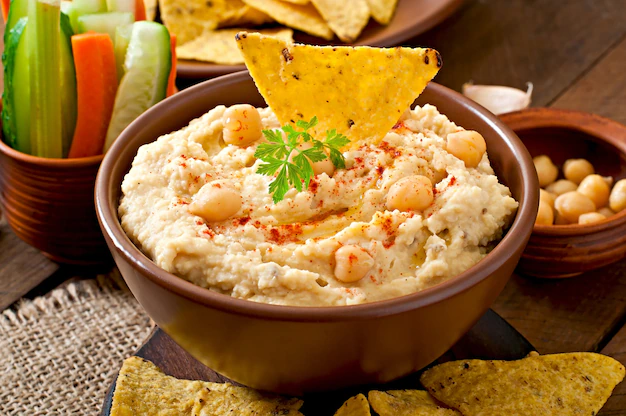Traditional Hummus

Hummus is a traditional Middle Eastern dip that has gained popularity all around the world. It’s made from cooked chickpeas that are blended with tahini (sesame seed paste), lemon juice, garlic, and olive oil. It’s typically served as an appetizer with pita bread, crackers, or fresh veggies. In this blog post, we will explore the history of hummus, the nutritional benefits of its ingredients, and a recipe to make it at home.
History of Hummus
Hummus has been a staple of Middle Eastern cuisine for centuries. It’s believed to have originated in ancient Egypt and has been a popular dish in the Levant (Syria, Lebanon, Israel, Palestine, and Jordan) for thousands of years. The word “hummus” actually means “chickpeas” in Arabic. Over the years, the recipe has evolved and adapted to different regions and cultures, and it has become a popular dish all around the world.
Nutritional Benefits of Hummus
Hummus is a healthy and nutritious dip that offers a variety of health benefits. Chickpeas are a great source of plant-based protein, fiber, and complex carbohydrates. They’re also high in iron, folate, and other important vitamins and minerals. Tahini is rich in healthy fats, protein, and minerals like calcium and magnesium. Garlic is known for its antibacterial and antiviral properties, and lemon juice is a good source of vitamin C.
Recipe for Traditional Hummus
Ingredients:
- 2 cups cooked chickpeas (or 1 can chickpeas, drained and rinsed)
- 1/4 cup tahini
- 1/4 cup lemon juice
- 2-3 cloves garlic, minced
- 1/4 cup olive oil
- 1/4 cup water (or more as needed)
- Salt to taste
Instructions:
- If using dried chickpeas, soak them overnight in water. Drain and rinse the chickpeas, then cook them in a pot of boiling water until they’re tender (around 45-60 minutes). If using canned chickpeas, skip this step.
- In a food processor, combine the cooked chickpeas, tahini, lemon juice, garlic, and salt. Process until smooth.
- While the food processor is running, slowly pour in the olive oil and water. Continue processing until the hummus reaches a smooth and creamy consistency. If the hummus is too thick, add more water as needed.
- Taste the hummus and adjust the seasoning as needed.
- Transfer the hummus to a serving bowl and drizzle with extra olive oil.
- Serve the hummus with pita bread, crackers, or fresh veggies.
Conclusion
Traditional hummus is a delicious and nutritious dip that is easy to make at home. It’s a great source of plant-based protein, fiber, healthy fats, and important vitamins and minerals. Try making this hummus recipe for your next party or as a healthy snack option, and impress your guests with its authentic Middle Eastern flavor.
